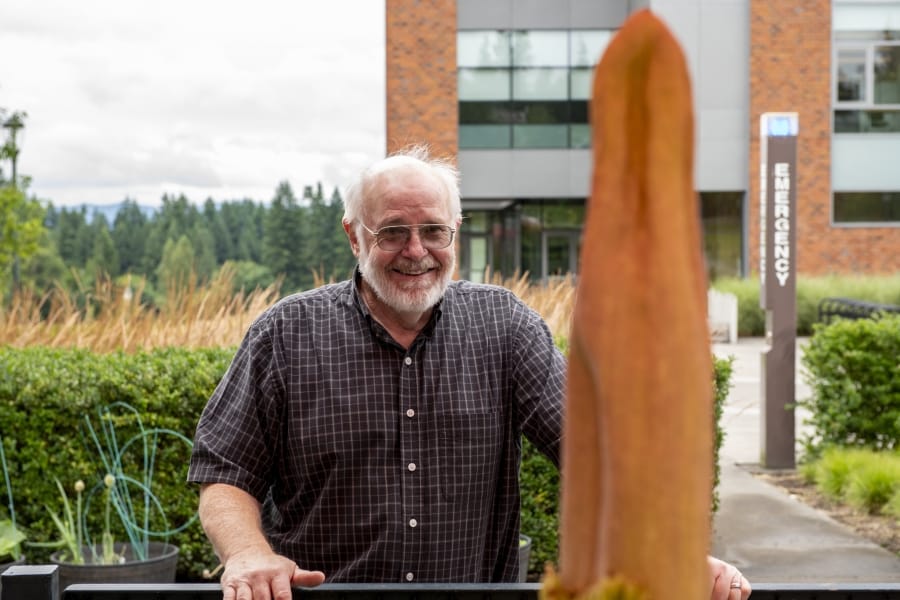Titan VanCoug, the rare corpse flower planted at Washington State University Vancouver, has been a real tease over the years.
But this time, it looks like it’s for real: The rare plant native to Sumatra could bloom any day now, releasing its trademark stench of dirty socks and rotten fish at the Salmon Creek campus.
It’s not exactly what every parent wants for their babies, but Steven R. Sylvester, a WSU Vancouver professor of molecular bioscience, has been waiting for this for 17 years.
“I feel like an expectant father,” he said. “I worry about it every day.”
Sylvester has been raising the corpse flower, Latin name Amorphophallus titanum, from seed all this time. It started like any house plant, perched on his desk, but soon grew too big for his office — as in, 14-feet tall. In typical years, the corpse flower’s underground corm, a bulbous mass, sends off huge stalks of leaves, almost like tree trunks. The leaves collect energy from the sun, storing it in the corm in anticipation of blooming.
When those leaves started shooting off, Sylvester had to move Titan VanCoug to a sun-soaked stairwell in the campus Science and Engineering Building, where the stalks could stretch out without hitting the ceiling.
“This is the only place it could be,” Sylvester said.
The leaves typically fall and die, and the plant becomes dormant again. It usually takes seven to 10 years for a corpse flower to bloom, but an overzealous waterer gave the plant too much water in 2008, causing the corm to clone and starting the process over again. It looked like the plant was going to bloom in 2017, but what Sylvester thought was going to be a bloom turned out to be a stalk of leaves.
But this year, after the dormant period, the corm shot off a spike, a sort of asymmetrical bud encircled in a frilly green leaf. Since June 1, the plant has grown about 2 inches a day, a sure indicator that a bloom is coming. The growth will stop about four days before the leaves open, their insides a bright purple. Male and female flowers will cover the spike inside the flower, giving off that foul, carrion-like odor Indonesian pollinators such as flies and dung beetles find so tempting. The flower will only bloom for 24 to 48 hours, then die off.
For now, Titan VanCoug is set up outside for curious passersby to inspect, and to save the noses of everyone working and attending classes in the building.
“We didn’t want it to stink up the whole building,” Sylvester said.
Corpse flowers are rare, their native Sumatran rainforests under threat by major deforestation. The International Union for Conservation of Nature lists the plant as an endangered species. But caretakers like Sylvester are ensuring the plant lives on, even if it is a bit far from home. He received the seed from Mohammad Fayyaz, a scientist and former director of the University of Wisconsin Madison Botany Greenhouse and Botanical Garden. Titan VanCoug has relatives across the country, Sylvester said.
He hopes that, once the corpse flower blooms, he’ll be able to pass on seeds to new tenders. He’s working to secure pollen from The Royal Botanic Garden Edinburgh in Scotland so he can pollinate the flowers, sending them to fruit and seed. In the wild, birds would eat the berry-like fruit, spreading the seeds through their poop. Sylvester will stick with mail, sending seeds off to universities, botanical gardens and elsewhere.
“I’m very anxious to see it,” Sylvester said.
The olfactory curious can visit Titan VanCoug from 8 a.m. to 9 p.m. Monday through Friday, and from 10 a.m. to 6 p.m. on weekends. The campus is at 14204 N.E. Salmon Creek Ave. You can also watch a live stream of the plant at WSU Vancouver’s YouTube page: www.youtube.com/wsuvancouver.




